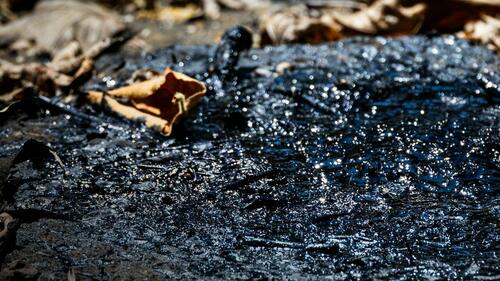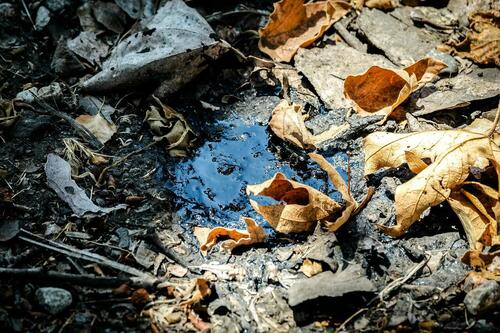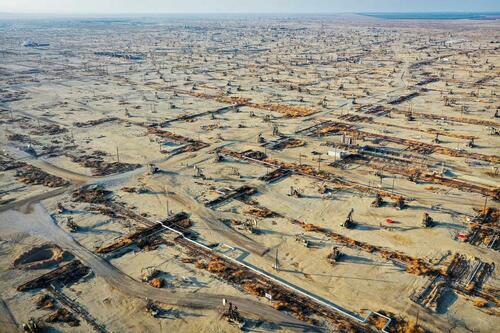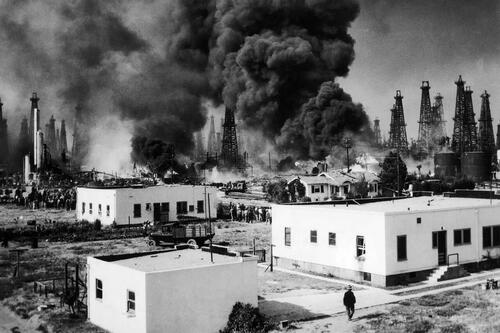How Oil Production Might Help California Meet Its Environmental Goals: Study
Authored by Beige Luciano-Adams via The Epoch Times (emphasis ours),
LOS ANGELES—When students in Jamie Rector’s Energy and Civilization course at the University of California–Berkeley came to him with the idea for a project on California’s abandoned oil wells, he was intrigued.

The state has more than 120,000 abandoned oil and gas wells, as well as 30,000 idle wells and 70,000 active wells. Many were drilled or dug in the late 1800s, clustered in areas such as downtown Los Angeles and near present-day Dodger Stadium, where the California oil boom began.
The concern among some is that these wells might be emitting methane or other hydrocarbons. Older ones are likely to have been improperly or shallowly sealed.
The federal government has spent $4.7 billion to plug and reclaim abandoned wells. California has plugged about 1,400 wells at a cost of $29.5 million since 1977, and now requires operators to eliminate idle wells or face increasing fees.
As they researched California’s abandoned oil wells, Rector’s students discovered an abundance of natural oil seeps located above the same fields—and came to a surprising conclusion. According to them, geologically driven, natural oil seeps are a major contributor to California’s greenhouse gas emissions. And drilling—long seen as the problem, not the answer—might be a panacea for emissions.
Natural seeps occur when liquid oil and gas leak to the Earth’s surface, both on land and under water. California sits on actively moving tectonic plates, which create fractured reservoirs and pathways for the oil to escape.
Waters off Southern California are rife with seeps, and oil and gas fields, including the Salt Lake field beneath the La Brea Tar Pits, and the Coal Oil Point field off the coast of Goleta, have some of the highest natural hydrocarbon seep rates in the world, emitting gases such as methane, as well as toxic volatile organic compounds (VOCs).
But these geologically driven seeps, Rector said, have been largely unaccounted for in assessing how oil production fields contribute to California’s greenhouse gas emissions.
“There are hundreds of studies linking oil and gas fields to greenhouse gas emissions, to cancer rates, to climate justice, to groundwater pollution and everything else,” said Rector, a professor in the University of California–Berkeley’s Civil and Environmental Engineering Department. “And yet none of these studies ever considered the possibility that it wasn’t from equipment or production, but natural seeps above the oil fields.”
Reviewing existing literature, Rector’s team calculated that natural seeps, together with orphaned wells, produce 50 times more methane emissions than oil and gas equipment leaks in Southern California.
If seeps are driving emissions above oil fields, Rector said, then plugging abandoned wells may do little to help pollution.
In fact, he said, the only demonstrated way to reduce natural seep emissions is by depleting underlying reservoirs—that is, by drilling.

Pointing to studies showing that oil production has reduced and even eliminated seeps, he suggested that California’s current regulatory environment may be counterproductive.
“The crazy thing is, by stopping oil and gas production in California, after we’ve regulated and really gotten equipment emissions way down, we may be increasing seep emissions,” Rector said. “Because these seeps come up through the oil and gas fields, and the only way to stop it is by producing oil.”
Ira Leifer, a researcher in the Department of Chemical Engineering at the University of California–Santa Barbara, said the argument is valid but that Rector’s analysis gets ahead of available data.
“The problem is that there is no statewide seep emissions estimate,” said Leifer, who studies marine seeps and oil field emissions. Arriving at a publishable estimate is “impossibly difficult,” he said.
Rector characterized the student project as a “skunkworks” effort without any funding, which he said he planned to submit for peer-review by August. Ideally, it will be followed by field research.
“We will have to go out and make measurements with the hypothesis that seeps are the principal cause rather than oil field equipment, and make measurements along traces of faults, above oil fields where faults intersect the surface,“ he said. ”That’s really the only way we’ll get to the bottom of this.”
Meanwhile, Leifer is working on his own forthcoming paper analyzing satellite data of methane anomalies. The strongest ones, he said, are associated with refining and other large infrastructure, and with natural faults that have been punctured by man-made wells—something he calls “anthropogenically amplified seepage.”
Of Rector’s paper, he said: “I fundamentally agree with their conclusion. I just don’t think it can be supported with data at this point.”
Leifer acknowledged that petroleum-related hydrocarbon emissions, including a “poorly understood” geological component, “clearly are extremely significant to overall California methane budget emissions,” based on spatial patterns from satellite data he has been studying for years.
Both Leifer and Rector agree that so far, emissions from orphaned wells and natural seeps have not been differentiated. Thus, the critical question remains unanswered: How much does natural seepage contribute to overall emissions?
While California has some of the highest concentrations of recoverable oil and gas in the world, it also boasts the most stringent oil and gas regulations in the country, and production has been in steady decline as the state aims for a 2045 “decarbonization” goal.

“If we’re really worried about emissions, pollution, disadvantaged communities, health—even fire danger, earthquakes and public safety—this is all affected by seeps,” Rector said.
By relying on studies that have broadly ignored them, he said, policymakers may have unknowingly implemented counterproductive policies.
Ancient Rocks, Modern Problems
Los Angeles sits atop one of the most petroleum-dense basins on the planet. Rector cited a 2015 U.S. Geological Survey (USGS) study estimating that there are still 1 billion barrels of recoverable oil in the Los Angeles Basin. This year, the USGS estimated that 61 million barrels of recoverable oil and 240 billion cubic feet of gas remain.
The organic-rich sediment beneath us is oil-prone and “relatively immature,” Rector said, and hydrocarbon generation is ongoing. Massive natural seeps such as Coal Oil Point off the coast of Santa Barbara, California—one of the largest seep fields in the world—continue to actively produce petroleum.
Seeps concentrated along the coast are fed by adjacent reservoirs deep within sedimentary rock beneath the region’s oil and gas fields.
California’s geology is also uniquely affected by actively shifting tectonics. Along with organic-laden sediment deposits, the shifting plates create conditions for rich petroleum accumulations, as well as natural seepage and hydrocarbon venting, Rector said.
Oil fields both in the Los Angeles Basin and throughout Southern California, he said, tend to concentrate along fault lines, allowing oil generated down deep to migrate into shallower pools and eventually make its way to the surface.
The La Brea Tar Pits in Los Angeles is one of the largest seepage sites in the state, and hydrocarbon gas emissions there are the highest on record for any onshore seepage site in the United States, according to a 2017 research article published in the Journal of Geophysical Research: Atmospheres.
California’s bubbling tar pits have been part of human culture for millennia, their bitumen used by the Chumash Tribe as a sealant long before anyone showed up to drill for oil.
When they did, in the late 1800s, surface seeps and methane vents played a crucial role in the California oil boom, during which most of the state’s large oil fields were discovered, starting with the Los Angeles Oil Field.
“Back a hundred years ago, they had people, they were called ‘smells,’ and they would smell the ground trying to see if there were oil seeps in an area,” Rector said, describing how early oil pioneers would decide where to dig.

More recently, trapped oil and methane have offered a pointed reminder of the city’s ancient subterranean history, including the mysterious 1985 explosion at a Ross Dress for Less store near the La Brea Tar Pits that sent 23 people to the hospital.
In a report the same year, a city task force noted that the source of the explosion was likely natural seepage of methane gas.
Oil production in Los Angeles County has declined dramatically since its peak in the 1920s, when it was one of the most prolific producers in the world.
But the infrastructure left in place—and whatever interaction it may have with naturally occurring seeps—remains vast and, in some ways, hidden in plain sight.
Health Impacts
In a 2023 paper exploring health impacts of oil and gas facilities on “cumulatively burdened” communities in Los Angeles County, researchers point to this hidden infrastructure.
“As government and industry negotiated to continue oil drilling within residential zones, oil extraction in L.A. County became increasingly hidden from public view, often by utilizing tall walls or hedges, and consolidating operations into fewer neighborhoods,” the authors and university researchers wrote.
Read the rest here…
Tyler Durden
Tue, 08/12/2025 – 20:55ZeroHedge News




 T1
T1



